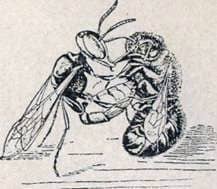
Take, for example, a bee-wolf. In fact, this is not a wolf at all, but a burrowing single wasp (philanthropist), which has received such a name for its predatory propensities. Digging wasps are close to social wasps, but live alone, hunting various insects, feeding their larvae, each type of burrowing wasps hunting for a certain prey and skillfully able to track and overcome it. The bee-wolf chose as its prey a well-armed honey bee. Slightly larger than a bee, but much more dexterous than she, a philanthropist attacks a bee when she works on a flower, sticks a sting in her neck or a soft joint between the front and middle chest, as if knowing for sure that this is her Achilles heel.

Fig. 100. The bee-wolf attacks the honey bee.
Then the philantine grabs the belly of the bee in the place where the honey zobik is, squeezes out of it through the mouth the nectar collected by the bee from the flowers for a completely different purpose, and is reinforced by it. Now, pressing the bee to his belly, the philanthropist flies with her to the hole, previously dug in the sandy soil. A deep corridor leads to the brood room. Having placed here three or four bees shoulder to shoulder, the philantine lays one egg and starts to work in another brood branch of the nesting or starts digging a new burrow.

Figure 101. The nest of a bee-wolf. The larva eats paralyzed bees. (According to the drawing by G. Tim, somewhat changed.)
A larva, similar to a fly larva, is hatched from the egg, which immediately begins to devour one by one the bees prepared for it. Since the bees are not killed, but only paralyzed by the sting of the wasp, they remain fresh, like well-preserved meat reserves. At the same time, they are defenseless and given into the power of a lazy larva. The grown larva pupates, and the next summer a young wasp leaves the nest, which continues the work of its mother.
In some areas, where the bee-wolf finds favorable conditions for nesting, it can cause great harm. In the Thuringian-Hessian region, rich in limestone, in the valley of the River Verry, he is particularly eager to settle in dumps located near the brown-coal and salt mines. Once it came to such a mass reproduction of these wasps that beekeeping was under serious threat – some beekeepers even completely abandoned this occupation.
This continued until the costly measures could not cope with this disaster. As a result of a careful survey of the nests on the soil surface of 150 meters in length and 100 meters in width for the year, almost two million aspen victims were found, which corresponds in number to approximately 50 beehives of bees.
Лечебные.травы.с.медом.. Чем отличается перга от пыльцы.
Predator bees